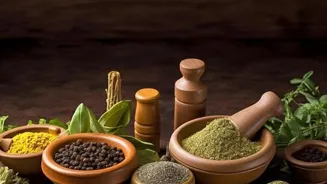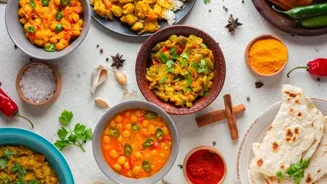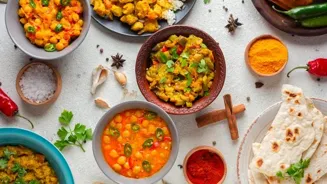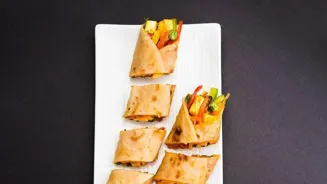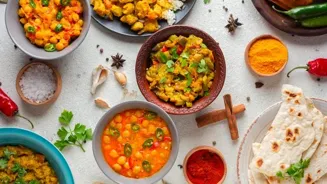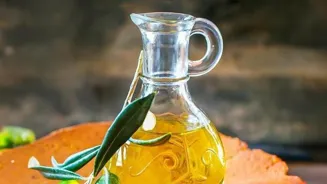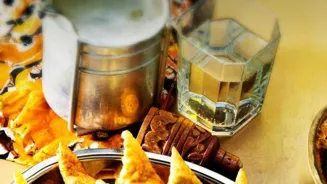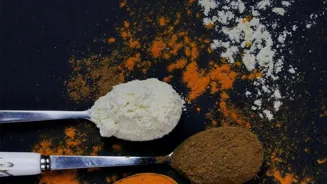Unlock the Magic of Indian Cooking: Essential Techniques for Beginners. Dive into a flavorful journey!
Namaste, food lovers! Ever dreamt of recreating the aromatic and flavourful dishes you relish at your
favorite Indian restaurant, right in your own kitchen? Indian cooking might seem daunting at first, with its array of spices and techniques, but fear not!
This guide will help you conquer the basics and embark on a delicious culinary adventure. We've broken down seven essential techniques that will empower you to create authentic and mouthwatering vegetarian Indian meals. So, put on your apron, gather your ingredients, and let's get cooking!
Tadka: The Tempering Magic
Tadka, also known as tempering or seasoning, is one of the most fundamental techniques in Indian cooking. It involves heating oil or ghee (clarified butter) and then adding whole spices, such as mustard seeds, cumin seeds, and dried red chilies.
As the spices sizzle and release their aromatic oils, they infuse the fat with their essence. This flavourful oil is then poured over a dish, adding a burst of flavour and texture. The process is simple, but it makes a huge difference. Try it with dals to add depth and richness.
The key to a perfect tadka is to use the right amount of heat. Low heat won't allow the spices to release their full flavour while high heat can burn them, resulting in a bitter taste. Start with medium heat and adjust as needed.
Once the mustard seeds start popping and the cumin seeds turn golden brown, your tadka is ready. Remember to immediately pour the hot oil over the dish to capture the aroma. Don't be afraid to experiment with different combinations of spices.
Curry leaves, asafoetida (hing), and ginger are all great additions to a tadka. Tadka technique can be used over dals for adding greater value and aroma.
Apart from adding flavour, tadka can also improve the digestibility of certain dishes.
For instance, asafoetida, often added to dals, helps reduce bloating and gas. The hot oil also helps to soften the spices, making them easier to digest. Mastering the art of tadka will elevate your Indian cooking skills significantly.
It will add a layer of complexity and flavour to even the simplest of dishes. It is very simple to create and anyone can give a go at their home. So, go ahead and make tadka a staple in your Indian cooking repertoire!
Bhuna: The Art of Sautéing
Bhuna is the slow and deliberate process of sautéing ingredients, typically onions, ginger, garlic, and spices, in oil or ghee until they release their aroma and flavors intensify. It forms the base for many Indian curries and stews. The key to a good bhuna is patience.
You need to cook the ingredients slowly over medium-low heat, stirring frequently to prevent them from sticking to the pan and burning. As the onions caramelize and the spices bloom, they create a rich and complex flavour profile.
The technique involves adding ingredients in a specific order.
Typically, onions are sautéed first until they turn translucent and start to brown. Then, ginger and garlic are added and cooked until fragrant. Finally, the spices are added and sautéed until they release their aroma. Tomatoes are sometimes added towards the end to create a tangy base.
Bhuna requires time and patience so it is vital to follow procedure carefully. Always add little water so that things are not burning.
The bhuna process is essential for a well-balanced and flavorful curry. It allows the spices to meld together and create a cohesive flavor profile.
It also helps to break down the raw flavors of the onions, ginger, and garlic, resulting in a smoother and more palatable dish. By mastering the art of bhuna, you'll be able to create a wide range of delicious and authentic Indian curries.
It can be done in any pot or pan but it is ideal to use a cast iron pan. Do not forget to stir at regular intervals.
Basic Spice Blends: The Flavor Foundation
Indian cuisine is renowned for its complex and aromatic spice blends. While you can buy pre-made spice mixes, creating your own allows you to customize the flavor to your liking. Some of the most essential spices in Indian cooking include turmeric, cumin, coriander, garam masala, and chili powder.
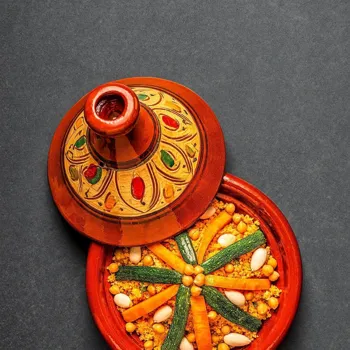
Turmeric adds color and has anti-inflammatory properties, cumin adds a smoky and earthy flavour, and coriander adds a citrusy and fresh note. Garam masala is a blend of warm spices that adds depth and complexity, while chili powder adds heat.
Experimenting with different combinations of these spices is the key to creating your signature spice blends. Start with small quantities and adjust to your taste. You can also roast the spices before grinding them to enhance their flavor.
Store your spice blends in airtight containers in a cool, dark place to maintain their freshness. When adding spices to your dishes, remember to add them in the right order. Whole spices should be added at the beginning of the cooking process, while ground spices can be added later.
Creating your own spice blends allows you to control the quality and freshness of the ingredients. It also gives you the freedom to experiment and create unique flavors that reflect your personal taste.
By mastering the art of spice blending, you'll be able to create a wide range of flavorful and authentic Indian dishes. Garam Masala, the most common of spice blends, can be customized to your preference. Learn a bit about each spice to ensure you are adding right spice to the dish.
Roti/Chapati Making: The Daily Bread
Roti, also known as chapati, is a staple in Indian cuisine, served with almost every meal. It is a simple unleavened flatbread made from whole wheat flour (atta), water, and a pinch of salt. Mastering the art of making roti is essential for any aspiring Indian cook.
The key to a soft and pliable roti is to use good quality atta and knead the dough well. The dough should be soft and elastic, but not sticky.
After kneading the dough, let it rest for at least 30 minutes to allow the gluten to relax. This will make the roti easier to roll out.
Divide the dough into small balls and roll them out into thin circles. Cook the roti on a hot griddle (tawa) until small bubbles appear on the surface. Then, flip the roti and cook the other side until it is lightly browned.
Finally, puff up the roti over an open flame or on the griddle to ensure it is cooked through. Using hot tawa is essential so the roti cooks nicely.
Making roti may seem intimidating at first, but with practice, it becomes a simple and rewarding task. There are so many videos that can help make it.
Serve the roti hot with your favorite Indian dishes. A little bit of ghee or butter on top makes it tastier. You can also experiment with different types of flour, such as millet flour (bajra atta) or sorghum flour (jowar atta), to create variations of roti.
Chapati is a flat bread made out of atta and is a very simple version to make.
Rice Cooking Techniques: Fluffy Grains Every Time
Rice is another staple in Indian cuisine, served alongside dals, curries, and vegetables. While cooking rice may seem simple, there are a few tricks to ensure perfectly cooked, fluffy grains every time. The key is to use the right ratio of water to rice and to cook the rice over low heat.
There are several methods for cooking rice, including the absorption method, the boiling method, and the pressure cooker method.
The absorption method involves adding a specific amount of water to the rice and cooking it until all the water is absorbed.
This method results in fluffy rice with distinct grains. The boiling method involves boiling the rice in excess water and then draining the water once the rice is cooked. This method is good for parboiled rice. The pressure cooker method is the quickest way to cook rice.
It involves cooking the rice in a pressure cooker with a specific amount of water. Whichever method you choose, remember to rinse the rice before cooking to remove excess starch.
Adding a pinch of salt or a teaspoon of oil to the cooking water can also improve the texture and flavor of the rice.
Once the rice is cooked, fluff it with a fork and let it rest for a few minutes before serving. Serve the rice hot with your favorite Indian dishes. You can also flavor the rice with spices, herbs, or vegetables to create variations such as pulao or biryani.
Rice needs to be cooked over low heat for best results. Always stir the rice at regular intervals.
Dal Preparation: The Hearty Lentil Stew
Dal, a lentil-based stew, is a staple in Indian cuisine, packed with protein and fiber. There are many different types of dals, each with its unique flavor and texture. Some of the most popular dals include moong dal, toor dal, urad dal, and chana dal.
Preparing dal involves simmering the lentils in water or broth until they are soft and creamy. The key to a good dal is to use good quality lentils and to cook them slowly over low heat.
Before cooking the lentils, rinse them thoroughly to remove any impurities.
You can also soak the lentils for a few hours to reduce cooking time. Add spices, such as turmeric, cumin, coriander, and chili powder, to the dal to enhance its flavor. You can also add vegetables, such as tomatoes, onions, and spinach, to make the dal more nutritious.
Once the dal is cooked, temper it with a tadka of spices and ghee to add a final burst of flavor. Cook the dal in a pressure cooker to reduce cooking time.
Serve the dal hot with rice or roti. Dal is a hearty and nutritious dish that is perfect for a quick and easy meal.
It's best to keep the flame very low while preparing dal to keep it from burning. Experiment with different types of dals and spices to create your signature dal recipe. Dal is a very nutritious and a staple vegetarian food. Dal tadka and dal makhani are two of the most popular dals.
Understanding Regional Variations
India is a country with diverse culinary landscape, and regional variations are integral to understanding Indian food. The dishes of North India, and South India are very different. North Indian food is famous for its rich curries, tandoori dishes, and bread.
South Indian food is known for its rice-based dishes, sambar, and dosas. Eastern India offers sweets and dishes. Finally, western india offers its great and unique dishes. Traveling is the best way to try them all.
Each region also has its distinctive spice blends and cooking techniques.
For example, dishes include use of mustard oil for flavors. Traveling is a good way to learn more. South Indian dishes often include use coconut milk and tamarind. Learning about regional variations will enable you to appreciate and dishes even more.
Do not be afraid to try out all the diverse cuisines. You can try new things always. Experiment with what is available and what you like.
Indian dishes, are known over the world today.
With these seven basic techniques under your belt, you're well on your way to mastering the art of Indian cooking.
Remember to be patient, experiment with flavors, and most importantly, have fun! Happy cooking!
AI Generated Content. Glance/InMobi shall have no liability for the content